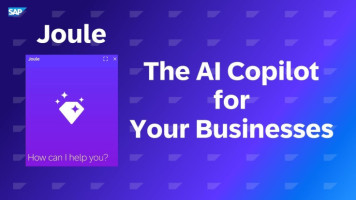Integrating Non-SAP Apps with SAP CPI: Solving Real Business Bottlenecks with Pre-Built Content
- Posted on September 10, 2025
- SAP BTP
- By ROI Blogger
- 231 Views

In the enterprise landscape of 2025, homogeneity is a relic of the past. Today’s businesses thrive on a "best-of-breed" strategy, where SAP S/4HANA forms the powerful operational core, but it's surrounded by a constellation of specialized cloud applications. Your sales team lives in Salesforce, your HR department manages talent in Workday, and your customer service operates out of ServiceNow. While each application is a powerhouse in its own right, this distributed architecture creates a significant, often invisible, drag on the entire organization: the integration gap.
This gap is where business processes break down. It’s the source of manual data entry, frustrating sync delays, and costly errors. It’s the reason a new customer signed in Salesforce takes 24 hours to appear in the SAP billing system, or why a newly hired employee in Workday has to be manually set up in three different downstream systems.
The solution isn't more manual effort; it's intelligent automation. This is where SAP Cloud Platform Integration (CPI), now a core part of the SAP Integration Suite, becomes the digital glue for the modern enterprise. More specifically, its vast library of pre-built content offers a powerful shortcut to solving these real-world business bottlenecks without reinventing the wheel.
The High Cost of Disconnected Systems: Data Duplication and Sync Delays
Before diving into the solution, it’s critical to understand the tangible costs of poor integration. These aren’t just minor IT headaches; they are fundamental business process failures.
-
Manual Data Duplication: This is the most obvious bottleneck. A sales representative closes a deal in Salesforce. To fulfill the order, someone in the back office must manually re-enter the customer details, product information, and pricing into S/4HANA. Every manual keystroke is a potential point of failure. A typo in a customer address leads to a failed delivery. An incorrect product code delays the entire order-to-cash cycle. This process is not only slow and expensive in terms of person-hours, but it’s also fundamentally unreliable.
-
Synchronization Delays: In a fast-moving market, stale data is dangerous data. When your systems aren't in sync, different departments are working with different versions of the truth. Imagine your HR team processes a critical promotion and salary change in Workday. If that information doesn't flow instantly to the SAP payroll and finance systems, it can lead to incorrect compensation, compliance issues, and frustrated employees. Similarly, if a customer updates their contact information with the service team, but that change doesn't sync back to the CRM, the next sales outreach will be based on outdated information, damaging the customer relationship.
These issues create a reactive, inefficient organization that is always playing catch-up with its own data.
Your Integration Accelerator: Out-of-the-Box Content for Salesforce, Workday, and More
This is where the power of the SAP Integration Suite truly shines. Instead of asking you to build complex integrations from scratch, SAP and its partners have created a rich library of pre-built integration packages available in the SAP Business Accelerator Hub.
Think of these packages not just as technical connectors, but as pre-configured business process templates. They contain everything you need to get started: integration flows (iFlows), message mappings, adapter configurations, and detailed documentation. It’s the difference between building furniture from raw lumber versus assembling a flat-pack kit with all the parts and instructions included.
Here are two of the most common and high-impact examples:
Integrating with Salesforce
This is a classic requirement for almost any company running SAP. Pre-built packages can automate the entire lead-to-cash process.
-
Opportunity-to-Order: When a sales deal is marked "Closed-Won" in Salesforce, an iFlow can automatically trigger the creation of a sales order in S/4HANA, pulling all the relevant account, contact, and product data. This eliminates manual entry and dramatically accelerates order fulfillment.
-
Master Data Synchronization: Ensure consistency by automatically syncing product catalogs, pricing conditions, and customer master data between S/4HANA and Salesforce. This guarantees that sales reps are always quoting accurate, up-to-date prices.
Integrating with Workday
The hire-to-retire employee lifecycle is another critical process spanning multiple systems. Pre-built content for Workday ensures seamless HR operations.
-
New Hire Onboarding: When a candidate is marked as "Hired" in Workday, an integration flow can automatically create the employee master record (including personnel data, organizational assignment, etc.) in SAP S/4HANA or SAP SuccessFactors. This single event can trigger downstream account provisioning, payroll setup, and more.
-
Organizational and Financial Data Sync: Automatically synchronize cost centers, business units, and other financial structures between Workday and your SAP financial system. This ensures that your HR and financial reporting are always aligned.
Beyond these two, the SAP Business Accelerator Hub contains pre-built content for dozens of other applications, including ServiceNow, Microsoft Dynamics 365, Adobe, and many more, covering scenarios from IT service management to procurement.
Practical Implementation Tips: From Discovery to Deployment
Leveraging pre-built content is far simpler than custom development, but a methodical approach is still key to success.
-
Discover and Explore First: Before you start any project, go to the SAP Business Accelerator Hub. This is your catalog. Search for the non-SAP application you need to connect. Review the available integration packages. Read the documentation carefully to understand the business scenarios they cover, the data fields they map, and the specific configuration steps required.
-
Start with a Standard Scenario: Don't try to automate every single process on day one. Pick a high-value, low-complexity scenario first, such as syncing new customer accounts from Salesforce to S/4HANA. A quick win builds confidence and demonstrates the value of the platform to business stakeholders.
-
Focus on Configuration, Not Custom Code: The primary goal of using pre-built content is to avoid coding. Most of the work involves configuring the endpoints (providing system URLs), maintaining security credentials, and adjusting value mappings in the web-based interface. Resist the urge to fundamentally change the pre-built logic unless absolutely necessary.
-
Plan for Extensions: No two companies are the same. You will inevitably have custom fields or slightly varied processes. The beauty of the SAP Integration Suite is that you can copy a standard integration package and extend it. You can add new mapping steps for your custom fields or modify the logic to fit your unique workflow, all while using the standard package as a solid foundation.
-
Test End-to-End, Including Failures: Robust testing is non-negotiable. Don't just test the "happy path." Test what happens when a message fails. Does the system send an alert? Can you easily identify the failed message and reprocess it? The monitoring and error-handling capabilities of the Integration Suite are critical features that you need to understand and test thoroughly.
The Result: An Agile, Connected Enterprise
By leveraging SAP Integration Suite and its library of pre-built content, you can systematically eliminate the bottlenecks caused by a disconnected application landscape. The benefits go far beyond simply saving time on manual data entry.
You create a single, consistent source of truth across your entire organization, empowering your teams to make decisions based on real-time, accurate data. You accelerate core business processes, from fulfilling customer orders faster to onboarding new employees more efficiently. Most importantly, you build an agile and resilient enterprise, ready to adopt new applications and adapt to changing market demands without creating new data silos. In the connected economy of 2025, integration isn't just an IT task—it's a strategic business imperative.





Write a Response